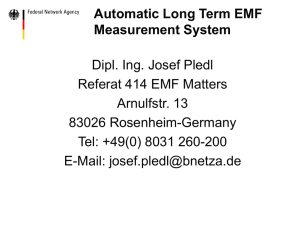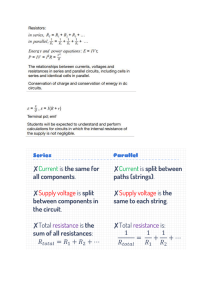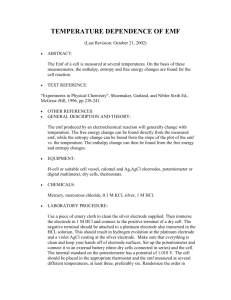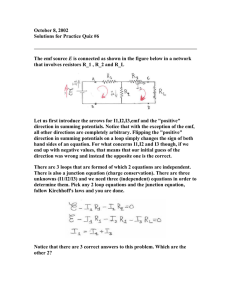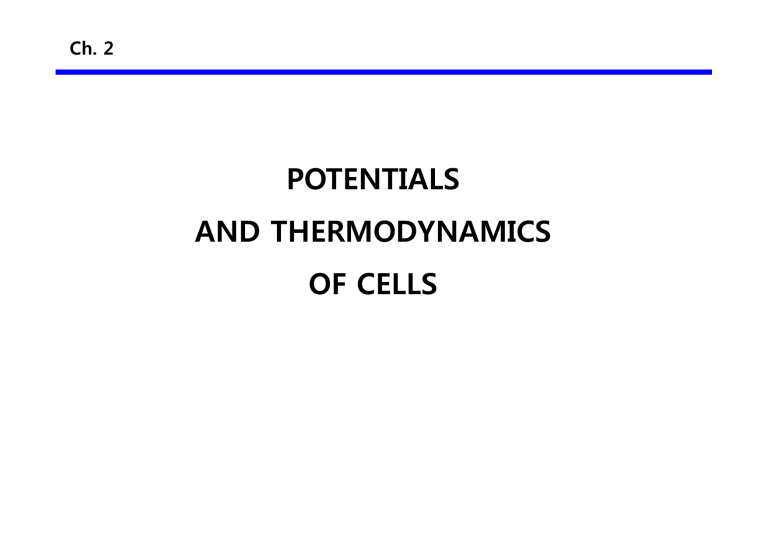
Ch. 2 POTENTIALS AND THERMODYNAMICS OF CELLS 2. Goal ▪ Our goal is to understand how potential differences are established and what kinds of chemical information can be obtained from them. ▪ These questions will be approached through thermodynamics. We will find that potential differences are related to free energy changes in an electrochemical system 2.1 BASIC ELECTROCHEMICAL THERMODYNAMICS 2.1.1 Reversibility ▪ Since thermodynamics can strictly encompass only systems at equilibrium, the concept of reversibility is important in treating electrochemical processes thermodynamically. ▪ The concept of equilibrium involves the idea that a process can move in either of two opposite directions from the equilibrium position. Thus, the adjective reversible is an essential one. ▪ Unfortunately, it takes on three different, but related, meanings in the electrochemical literature, and we need to distinguish three of them now. 1) Chemical reversibility 2) Thermodynamic reversibility 3) Practical (Electrochemical) reversibility 2.1.1 Reversibility (a) Chemical Reversibility ▪ Consider the electrochemical cell shown in the Figure ▪ Experimentally, the difference in potential between the silver wire and the platinum wire 0.222 V when all substances are in their standard states. ▪ The platinum wire is the negative electrode When the two electrodes are shorted together, the following reaction takes place (galvanic): 2.1.1 Reversibility ▪ If one overcomes the cell voltage by opposing it with the output of a battery or other direct current (dc) source (electrolytic), the current flow through the cell will reverse ▪ The new cell reaction is ▪ Reversing the cell current merely reverses the cell reaction. No new reactions appear Thus the cell is termed chemically reversible. 2.1.1 Reversibility ▪ On the other hand, the system ▪ is not chemically reversible. ▪ The zinc electrode is negative with respect to platinum (galvanic), discharging the cell causes the reaction ▪ At the platinum electrode, hydrogen evolves: 2.1.1 Reversibility ▪ Thus the net cell reaction is ▪ By applying an opposing voltage larger than the cell voltage (electrolytic), the current flow reverses, the reactions observed are ▪ One has different electrode reactions as well as a different net process upon current reversal; hence this cell is said to be chemically irreversible. 2.1.1 Reversibility (b) Thermodynamic Reversibility ▪ (Definition) A process is thermodynamically reversible when an infinitesimal reversal in a driving force causes it to reverse direction. ▪ Obviously this cannot happen unless the system feels only an infinitesimal driving force at any time ▪ Hence it must essentially be always at equilibrium. ▪ A cell that is chemically irreversible cannot behave reversibly in a thermodynamic sense. ▪ A chemically reversible cell may or may not operate in a manner approaching thermodynamic reversibility. 2.1.1 Reversibility (c) Electrochemical (Practical) Reversibility ▪ In electrochemistry, we frequently use the Nernst equation: to provide a linkage between electrode potential E and the concentrations of participants in the electrode process: ▪ If a system follows the Nernst equation or an equation derived from it, the electrode reaction is often said to be thermodynamically or electrochemically reversible (or nernstian). 2.1.2 Reversibility and Gibbs Free Energy ▪ Consider three different methods of carrying out the reaction: Zn + 2AgCl Zn2+ + 2Ag + 2Сl- 1) Suppose zinc and silver chloride are mixed directly in a calorimeter at constant, atmospheric pressure and at 25°C. - Assume that the extent of reaction is so small that the activities of all species remain unchanged during the experiment. - The amount of heat liberated when all substances are in their standard states 233 kJ/mol of Zn reacted. - Thus, 2.1.2 Reversibility and Gibbs Free Energy 2) Suppose we now construct the cell of the right figure, that is, - Discharge it through a resistance R. - Assume that the extent of reaction is small enough to keep the activities essentially unchanged. - During the discharge, heat will evolve i) from the resistor and ii) from the cell - Measure the total heat change by placing the entire apparatus inside a calorimeter. - The heat evolved 233 kJ/mol of Zn, independent of R. - That is, ∆ = -233 kJ, regardless of the rate (R) of cell discharge. 2.1.2 Reversibility and Gibbs Free Energy 3) Let us now repeat the experiment with the cell QR and the resistor in separate calorimeters. - Assume that the wires connecting them have no resistance and do not conduct any heat between the calorimeters. - If we take Qc as the heat change in the cell and Qc QR as that in the resistor QC + QR = -233 kJ/mol of Zn reacted, independent of R. - However, the balance between these quantities does depend on the rate of discharge (R). As R increases, - decreases and increases. In the limit of infinite R, QC approaches -43 kJ (per mole of zinc) and QR tends toward 190 kJ. 2.1.2 Reversibility and Gibbs Free Energy ▪ In this example, the energy QR : was dissipated as heat : electrical energy, it might have been converted to light or mechanical work. ▪ In contrast, QC : is an energy change that is inevitably thermal. ▪ Since discharge through R ∞ corresponds to a thermodynamically reversible process, the energy that must appear as heat in traversing a reversible path, Qrev, : is identified as lim → . 2.1.2 Reversibility and Gibbs Free Energy ▪ The entropy change, ΔS, is defined as Qrev/T ▪ Therefore, for our example, Because -ΔG: the maximum net work obtainable from the cell 2.1.3 Free Energy and Cell emf ▪ If the above electrochemical cell is discharged through an infinite load resistance The discharge reaction would be reversible. The potential difference is the equilibrium (open-circuit) value. ▪ Then, the energy dissipated in R is given by - n: the number of electrons passed per atom of zinc reacted (or the number of moles of electrons per mole of Zn reacted) - F: the charge on a mole of electrons, which is about 96,500 C. 2.1.3 Free Energy and Cell emf ▪ The actual meaning of the signs - and + different for free energy and potential. ▪ For free energy, - and + : energy lost or gained from the system ▪ The free energy change has a sign associated with the direction of the net cell reaction. We can reverse the sign by reversing the direction. 2.1.3 Free Energy and Cell emf ▪ For potential, - and + : the excess or deficiency of electronic charge ▪ Only an infinitesimal change in the overall cell potential is required to reverse the direction of the reaction Hence E is essentially constant and independent of the direction of a (reversible) transformation. ▪ We want to relate a direction-sensitive quantity (ΔG) to a direction-insensitive observable (E). This desire is the origin of almost all of the confusion that exists over electrochemical sign conventions. 2.1.3 Free Energy and Cell emf ▪ We rationalize the relationship between free energy and potential by inventing a thermodynamic construct called the emf (electromotive force) of the cell reaction. emf has a directional aspect. ▪ For the one in the following example, The reaction is ▪ The right electrode corresponds to reduction in the implied cell reaction, and the left electrode is identified with oxidation. 2.1.3 Free Energy and Cell emf ▪ Thus, the reverse of the above reaction would be associated with the opposite schematic: ▪ (Sign convention) The cell reaction emf, Erxn, is defined as the electrostatic potential of the electrode written on the right in the cell schematic with respect to that on the left. 2.1.3 Free Energy and Cell emf anode cathode 2.1.3 Free Energy and Cell emf i) ▪ For example, in the above cell, thus the emf of the below reaction, the spontaneous direction, is +0.985 V. ii) ▪ Likewise, the emf corresponding to the above cell is -0.985 V. The reaction is 2.1.3 Free Energy and Cell emf i) +0.985 V. ii) -0.985 V. ▪ By adopting this convention, we have managed to rationalize an electrostatic quantity (the cell potential difference), which is not sensitive to the direction of the cell's operation, with a thermodynamic quantity (the Gibbs free energy), which is sensitive to that direction. ▪ One can avoid completely the common confusion about sign conventions of cell potentials if one understands this formal relationship between electrostatic measurements and thermodynamic concepts 2.1.3 Free Energy and Cell emf ▪ Because our convention implies a positive emf when a reaction is spontaneous, ▪ or as above, when all substances are at unit activity, : is called the standard emf of the cell reaction. Practice Determine. Cell rxns? Their emf? Spontaneous? a) Ag/AgCl/K+, Cl-/Hg2Cl2/Hg b) Pt/O2 /Na+, OH- /H2 /Pt 2.1.4 Half-Reactions and Reduction Potentials 2.1.3 Free Energy and Cell emf ▪ Other thermodynamic quantities can be derived from electrochemical measurements ▪ For example, the entropy change in the cell reaction is given by the temperature dependence of ΔG: hence and 2.1.3 Free Energy and Cell emf ▪ The equilibrium constant of the reaction is given by 2.1.4 Half-Reactions and Reduction Potentials ▪ In the system ▪ Thus, we say that the standard potential of the Ag+/Ag couple is +0.799 V vs. NHE. ▪ Another valid expression is that the standard electrode potential of Ag+/Ag is +0.799 V vs. NHE. ▪ The standard emf of the Ag+ reduction is also +0.799 V vs. NHE, but that of the Ag oxidation is -0.799 V vs. NHE. 2.1.5 emf and Concentration ▪ Consider a general cell in which the half-reaction at the right-hand electrode is where the v's are stoichiometric coefficients. ▪ The cell reaction with NHE is then and its free energy is given from basic thermodynamics by ∆G = ∆G o + RT ln Q where ai is the activity of species i 2.1.5 emf and Concentration ▪ Nernst Equation provides the relationship between the potential of the O/R electrode vs. NHE and the activities of О and R. 2.1.5 emf and Concentration νR RT aR E=E − ln ν O nF aO 0 or νO RT a E0 + ln Oν R nF aR RT 8.3145 J ⋅ K −1 ⋅ mol −1 × 298 K 0.0257 J ⋅ C −1 0.0257 = = = V nF n × 96487C ⋅ mol −1 n n νO νO 0 . 0257 a 0 . 0591 a E = E0 + ln Oν R = E 0 + log Oν R n aR n aR [V] 2.1.6 Formal Potentials ▪ It is usually inconvenient to deal with activities in evaluations of half-cell potentials, because activity coefficients are almost always unknown. A device for avoiding them is the formal potential, E0'. ▪ For example, Its Nernst relation is simply where Ci : the concentration of the solute C0 : the standard concentration (usually 1 M) 2.1.6 Formal Potentials formal potential, E0'. 2.1.6 Formal Potentials ▪ E0' will vary from medium to medium because the ionic strength affects the activity coefficients

